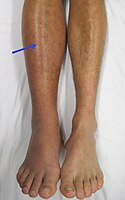
Photo from wikipedia
A 42-year-old man with a history of chronic hepatitis B, maintained on tenofovir, was evaluated for cough and shortness of breath. After initial evaluation in the outpatient setting demonstrated a… Click to show full abstract
A 42-year-old man with a history of chronic hepatitis B, maintained on tenofovir, was evaluated for cough and shortness of breath. After initial evaluation in the outpatient setting demonstrated a large right-sided pleural effusion, he was seen at his local Emergency Department where CT and subsequent MR identified a large (22.2 cm) Liver Reporting and Data System (LI-RADS) 5 mass occupying the right hepatic lobe (Fig. 1) that exhibited arterial-phase hyperenhancement, washout, and an enhancing pseudo-capsule. An enhancing tumor thrombus was also visible within the right main portal vein. Further evaluation identified an alpha fetoprotein (AFP) of 34,000 and a history of unintentional 15 lbs weight loss over a period of months. As a result of the large mass, the patient required multiple drainages for recurrent pleural effusions. He was empirically started on anti-vascular endothelial growth factor (VEGF) therapy with lenvatinib and referred to interventional radiology for consideration of radioembolization, but this was deferred due to an elevated shunt fraction, with approximately 3.6% shunting to the lungs. The patient was then referred for consideration of resection. Other than hepatitis B, he had no other pertinent medical history. This clinical situation presented a challenge in terms of devising a therapeutic plan that would maximize both quantityand quality-of-life in a young patient with a large HCC and macrovascular invasion. Treatment options under consideration included: continued anti-VEGF systemic therapy; trans-arterial chemo-embolization; radio-embolization; or surgical resection. Given the extant tumor thrombus occluding the right portal vein, combined with replacement of most of the functional right liver with large tumor, there was compensatory hypertrophy of the left lobe. The patient’s case was discussed in a multidisciplinary tumor board. Given the patient’s young age, the tumor board determined that an attempt at resection would be reasonable despite the large size and presence of macrovascular invasion. The patient was therefore brought to the operating room for right hepatectomy with tumor thrombectomy and portal venorrhaphy. The operation was completed successfully with a primary repair of the portal vein after extirpation of the tumor thrombus. An anterior approach (with early vascular control and hepatic division prior to right liver mobilization) was taken in order to minimize the chance of disrupting the tumor or dislodging tumor thrombus into the circulation during full hepatic mobilization [1]. No transfusions were required. Following an uncomplicated postoperative course, he was discharged home on postoperative day 5. He recovered well with only minor postoperative ascites, managed with furosemide and spironolactone. Final pathology demonstrated a 23 cm grade 2 moderately differentiated unifocal hepatocellular carcinoma with 0/4 positive lymph nodes. The final pathologic stage was pT4N0 with macrovascular invasion (Fig. 2). He has been seen in clinic most recently at 6 months after surgery with serial repeat imaging demonstrating no local or distant recurrence, a widely patent portal vein, and low-volume ascites (Fig. 3). He has now discontinued diuretic therapy and was initiated on adjuvant lenvatinib therapy (Fig. 4). * Brendan C. Visser [email protected]
Journal Title: Digestive Diseases and Sciences
Year Published: 2020
Link to full text (if available)
Share on Social Media: Sign Up to like & get
recommendations!